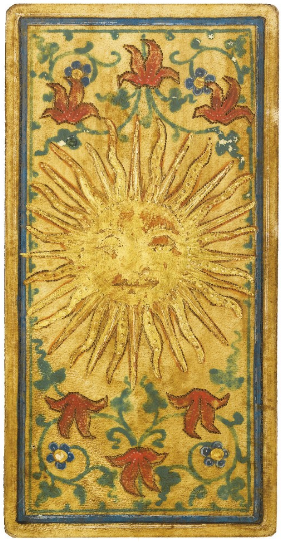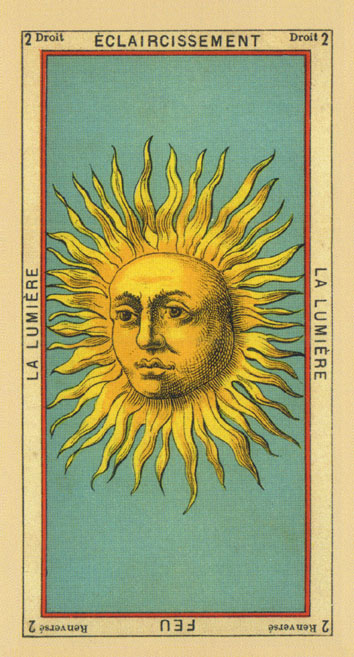The day after I had read Hucks Trionfi news thread
viewtopic.php?f=11&t=345&start=80#p9455
where he posted an illustration of a mysterious sun and moon card from the book "Il Castello dei Tarocchi", I realized that, in my own reply to this I had jumped to the conclusion that these mysterious cards had necessarily been derived directly from the Weltchronik.
(For the purposes of website SEO, in the rest of this post I will refer to it as the Nuremberg Chronicle, since that is the title people outside of German or Latin speaking areas of the western world usually use when searching for it, and that title hasn't been used on this forum yet.)
I realized that in fact these cards and the Nuremberg Chronicle itself could share a common source of artistic inspiration. Returning to this thread (started by Marco to continue the discussion on the mysterious cards and the Nuremberg Chronicle independently of Huck's Trionfi News thread.), I saw that Huck had made a post here on Dec. 28 which contains copious illustrations (from Durer, the Splendor Solis, etc. ) demonstrating the ubiquity of this sun and moon illustration. Now returning again I see from Marco's research and apparent acquisiton of the "Castillo del Tarocchi" (Is this true Marco, did you get one already?) which started this whole thing, that there is some strong evidence to suggest, (but not prove) that the Nuremberg Chronicle is the source of the art for these cards (I suppose this must be discussed in detail by the authors of the book

). His comparisons of the illos in the book, with the illos in the Chronicle are a big help to me and everyone else who cannot yet acquire a copy of the "Il Castello dei Tarocchi".
A major turn here (and one which surely must be of interest even to the authors of "Il Castello dei Tarocchi" themselves) is the work of Pen, who posted first in Huck's Thread -
viewtopic.php?f=11&t=345&start=90#p9489
Thanks Huck, that's helpful. I wondered whether Etteilla had copied the images from the Liber Chronicarum or from the deck of cards. Are there only five cards in existence?
His post and one lengthier that follows, finds a very suggestive link between quite a few cards of the Etteilla III deck and the Nuremberg Chronicle. This was followed up on by Ross G. R. Caldwell
viewtopic.php?f=11&t=345&start=90#p9491
immediately after, in Huck's thread. Then continued here in this thread, where Huck himself posted some very very enlightening illos documenting Pen's list of correspondences -
viewtopic.php?f=14&t=638#p9494
I think this is really important. Though the Etteilla III is from the mid-19th Century, it is still a remarkable discovery. I hardly ever read any documentation on the sources for the art in Tarot cards. Here we have at least 2 decks of cards, one from late 15th-early 16th Century, the other from the 19th, whose 'trumps' have striking ( and I mean striking!) similarities to the illustrations of one of the most famous books in the world.
Now Marco, in this thread, has made statements that he finds some sort of similarity with the Nuremberg Chronicle and the Sola Busca. This third claim is not yet clear, to me, at least.
Certainly, having the Nuremberg Chronicle online is a major advance for this research. The internet is changing what is possible, and in who can participate in those possibilities. I think that all these various antique books and maps that institutions and libraries and universities around the world are putting up in high resolution, now that we have DSL and broadband

is going to fuel a quantum leap in scholarship, knowledge, and the 21st Centuries ongoing worldwide cultural inflorescence, that will still look remarkable a thousand years from now (If we don't all blow each other to hell at the same time, of course:(
@Pen- Sister, you've made quite a discovery of your own. I hope you take it and run with it and someday have a paper or book of your own, just like the authors of "Il Castello dei Tarocchi"
http://trionfi.com/n/Deliver me from reasons why you'd rather cry - I'd rather fly...
Jim Morrison - The Crystal Ship





